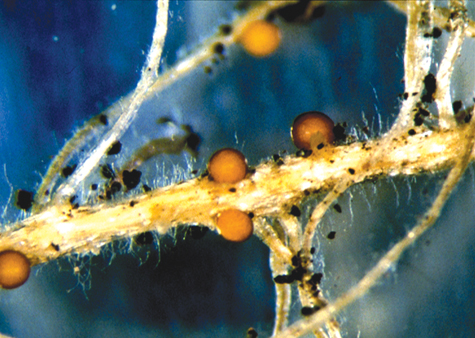Despite changes elsewhere, golden nematode still has North Fork potato farms under quarantine

Although more than 300,000 acres of western New York farmland were recently declared free of the golden nematode, a move that lifts strict regulations designed to eliminate the tiny but still lethal potato pest, Long Island farmland remains under a decades-old state and federal quarantine.
The golden nematode (Globodera rostochiensis) is a microscopic cyst-producing worm that mainly infects potatoes and tomatoes. The USDA considers the nematode “potentially more dangerous than any of the insects and diseases affecting the potato industry.” It’s a major pest in Europe but found domestically only in New York State.
First discovered on Long Island in Nassau County in 1941, the golden nematode was initially controlled by chemicals and subsequently by the development of nematode-resistant potato varieties and the regulation of infested land. Growers with infested acreage must follow a strict eradication strategy, including steam-cleaning equipment used on infested fields and a four-year crop rotation schedule that dictates the kind of crops a farmer can grow, said Sandy Menasha, a Cornell Cooperative Extension vegetable and potato specialist.
“If you are on infested land, you need to plant resistant potato varieties for two years, followed by a susceptible crop variety for a year and then a non-host crop the year after that,” she said.
In the two resistant-variety years, only the strongest nematodes survive, she said. Planting potato varieties susceptible to nematode infestation the following year incites the surviving nematode larvae to “hatch out.” Then in the fourth year introducing crops that the nematode cannot feed upon, such as corn, wipes out the remaining population.
But that rotation protocol is not popular with all local growers.
“I’ve got fields that state Department of Ag and Markets haven’t found nematodes on for over 30 years and still have to be in their quarantine program,” Jamesport potato farmer John Kujawski said.
The rotation schedule is necessary, Ms. Menasha said, because planting only nematode-resistant varieties would invite the worm to evolve, creating a sort of “super nematode.”
But if those varieties were not available for use in the rotation sequence, “people wouldn’t be able to grow potatoes out here,” Ms. Menasha said.
Even so, Mr. Kujawski, doesn’t feel he’s been done any favors by the development of the genetically modified crops.
“They aren’t anything to brag about and there’s always some kind of problem,” he said of resistant varieties he’s required to plant on 100 of his 500 acres. “The yield isn’t high and they get hollow heart, meaning there’s a hole in the middle. If a truck shipment shows over six percent have hollow heart in a sample, or two potatoes in a five pound bag, that shipment gets rejected. That costs a lot of money.”
In announcing the deregulation of the western New York acreage on Feb. 16, Ag and Markets Commissioner Darrel Aubertine called the move “a major first step” toward the goal of reducing nematode-regulated farmland by 90 percent by 2015. That would trim the 1.28 million quarantined acres down to 128,000.
But Mr. Kujawski isn’t holding his breath that his 100 acres will be deregulated that soon.
“If they find even one nematode, you’ll be in the program forever,” he said. The agency first found the nematodes in four or five of Mr. Kujawski’s 25 fields in 1964, and he’s been dealing with strict regulations ever since.
“Every year they change the rules about what we can do,” he said, “It’s all political b.s.”
Read more in Thursday’s issue of The Suffolk Times.








